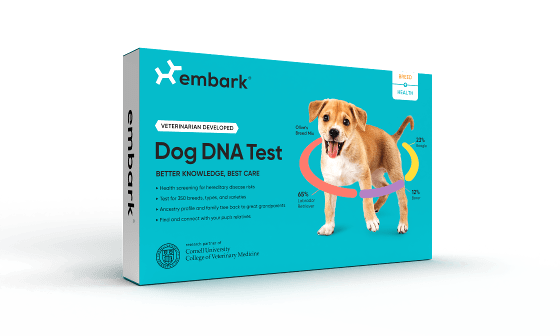In 2019, Embark scientists Adam Boyko, PhD and Aaron Sams, PhD published a study in the scientific journal G3 Genes|Genomes|Genetics investigating the genetic effects of inbreeding in domestic dogs.
They found that runs of homozygosity (especially longer ones) are associated with higher levels of known recessive disease alleles.
Genetic hallmarks of inbreeding
“Inbreeding is the mating of individuals or organisms that are genetically closely related, resulting in increased homozygosity and consequently an increase in the occurrence of recessive traits,” according to Nature.
When an individual inherits two identical alleles or chromosomal segments of DNA from the same ancestor, scientists describe this as autozygous. Another term for this effect is homozygous by descent.
What are runs of homozygosity?
Runs of homozygosity are chromosomal segments that are autozygous (or homozygous by descent). They are one genetic hallmark of inbreeding.
Matings between closely related organisms typically result in offspring with long runs of homozygosity (ROH). In general, the more closely related the organisms are, the longer the ROH. Matings of more distantly related individuals generally result in shorter ROH.
Efficient and accurate identification of ROH is especially important in conservation biology and in plant or animal breeding, to avoid inbreeding depression.
Accurate measurement of inbreeding
While inbreeding can be estimated from pedigrees, the pedigree-based coefficient of inbreeding (F) is exactly that—an estimate. It reports the expected level of autozygosity of the individual, rather than the true measure of inbreeding (the proportion of the genome that is identical by descent). Furthermore, in many populations, pedigrees may be inaccurate, incomplete, or missing, leading to incorrect or biased estimates of inbreeding. Even complete, accurate pedigrees can be misleading by implying that the pedigree founders are unrelated, when in fact they share some amount of DNA to begin with.
Genotyping by either whole-genome sequencing or arrays offers a more accurate method for detecting ROH and measuring autozygous segments of the genome. The coefficient of inbreeding derived from ROH is referred to as FROH.
How does ROH relate to inbreeding depression?
Because ROH are a direct consequence of inbreeding, the two concepts are closely related.
Long tracts of ROH can contribute to inbreeding depression if they contain deleterious (harmful) variants that are partially or fully recessive. However, the definition of “long” here is unclear. At what length is ROH considered “long”? Is there an ideal length threshold?
Dr. Boyko and Dr. Sams set out to investigate the effects of long ROH, using the domestic dog as a model.
Study methods
In the study, Dr. Boyko and Dr. Sams used two popular methods for estimating ROH:
- PLINK
- GERMLINE
The study included 1,792 dogs from 11 breeds. Dr. Boyko and Dr. Sams examined the association between ROH and known at-risk (homozygous recessive deleterious) genotypes in dogs. They hypothesized that at-risk genotypes would be more common in ROH regions compared to non-ROH regions.
The results between the two methods were broadly consistent, although the GERMLINE method was slightly more sensitive. For that reason, their findings below focus on the results using the PLINK method. For details on how Dr. Boyko and Dr. Sams used these methods, please see the Materials and Methods listed in the publication.
Key findings of the study
For this study, Dr. Sams and Dr. Boyko considered any ROH over 0.5 megabases to be “long.” (A megabase, abbreviated Mb, is a unit of measurement for the length of DNA. One Mb is equal to one million bases.)
They uncovered two main findings.
1. Long ROH contain ~30X more deleterious mutations than shorter ROH
Their primary finding demonstrated that long ROH (> 0.5 Mb) contained, at minimum, 29.8X more homozygous recessive deleterious alleles compared to shorter ROH (< 0.5 Mb). For all at-risk cases (excluding the SOD1 Degenerative Myelopathy allele), 92% of at-risk genotypes had an ROH overlapping the at-risk allele.
While it’s true that longer ROH contained more harmful alleles than shorter ROH, it’s important to note that even shorter ROH harbored deleterious mutations at a rate of about 30X higher than non-ROH regions.
2. Genome-wide ROH patterns highlight loss of genetic diversity within breeds and variation in ROH across breeds
Of the 11 breeds analyzed, the Doberman Pinscher had the highest overall levels of FROH. The Beagle genome had the lowest levels of FROH.
The authors also analyzed FROH of chromosome X (in females only) and compared it to the autosomes. In general, FROH of chromosome X followed the same patterns as the autosomes (with some exceptions).
The breeds studied (ordered from highest mean autosomal inbreeding to lowest) are:
- Doberman Pinscher
- Bulldog
- German Shepherd Dog
- French Bulldog
- Golden Retriever
- Yorkshire Terrier
- Border Collie
- Labrador Retriever
- Siberian Husky
- Poodle
- Beagle
For each breed, the authors also assessed the distribution of ROH by length across all dogs in the breed. These distributions highlight how changes in genetic diversity happened at different points in time for each breed.
ROH can be a useful tool for breeding decisions
This study by Dr. Boyko and Dr. Sams was the first to examine ROH in dogs to a resolution of 500 kilobases. (One kilobase is equal to 1,000 bases). They saw a clear pattern that known recessive deleterious alleles were enriched in ROH, regardless of ROH tract length. They suggest that even short tracts of ROH, which are often overlooked, may contribute more to inbreeding depression than previously thought.
Knowing the extent to which long vs. short ROH contribute to inbreeding depression offers a helpful tool for breeders who want to assess the risk posed by matings between distant relatives. Embark for Breeders tools, Pair Predictor and Matchmaker, provide genetic COI predictions that factor in this type of ROH information.
Further research is needed to examine the distribution of ROH across different types of recessive mutations, which is likely breed-specific.
Learn more about genome-wide quantification of inbreeding and how genetic COI can inform breeding decisions with Dr. Boyko and Dr. Sams.








